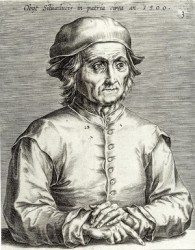
Baldass 1917
“Die Chronologie der Gemälde des Hieronymus Bosch” (Ludwig von Baldass) 1917
[in: Jahrbuch der königlichen Preuszischen Kunstsammlungen, XXXVIII (1917), pp. 177-195]
[Also mentioned in Gibson 1983: 41 (D2)]
In this article Baldass attempts to offer a chronology of the Bosch works that were known in 1917, based on a stylistic analysis. His text contains a number of obvious misconceptions and is outdated as a whole. Compare for example with Baldass 1959: 248-249, where a completely different chronology of Bosch’s oeuvre is presented.
Baldass divides the works of Bosch in three periods: an early, a middle and a later period. According to him the oldest Bosch painting that has come down to us, is the New York Adoration of the Magi (according to Unverfehrt 1980 this painting is not an authentic work, not even a copy of an authentic work). The following paintings also belong to the early period: the Philadelphia Adoration of the Magi, the Philadelphia Ecce Homo, the Ecce Homo (formerly in Berlin), the Madrid Cutting of the Stone, the four Venice altarpiece wings, the Berlin St. John on Patmos and the Madrid Carrying of the Cross. In this early period Bosch hardly shows any relationship with contemporary artists. He seems to be connected with the circle of the Van Eyck brothers, through a number of stepping stones which have been lost due to the iconoclastic fury. The chief work of this early period is said to be the Madrid Garden of Delights triptych.
In 2010 Bernard Vermet made a renewed plea in favour of an early dating of the Garden triptych, under the title ‘Baldass was right’. See Vermet 2010.
To the second period (approximately from 1490 till 1504) belong the Madrid Adoration of the Magi, the Ghent St. Hieronymus, the Madrid Temptations of St. Anthony, the Berlin Temptations of St. Anthony (according to Baldass a good contemporary copy), the Vienna Last Judgement (a faithful copy of an authentic work, painted between 1504 and 1508, compare Cranach’s copy in Berlin) and a Last Judgement which we know thanks to a Hieronymus Cock print. These works show a relationship with contemporary Netherlandish art in the broadest sense.
In his last period Bosch rarely shows any influences or relationships again. To this period belong the Crucified Martyr triptych (formerly Vienna, today in Venice), the Madrid Haywain triptych (this late dating – around 1510 – based on the clothes worn by the women on top of the haywain), the Lisbon Temptations of St. Anthony, the Vienna Carrying of the Cross (a copy – Baldass did not know the original, now in Vienna, yet), the Madrid Tabletop with the Seven Deadly Sins, the so-called Prodigal Son tondo (formerly Vienna, today Rotterdam), the St. Germain-en-Laye Conjuror, the Concert in an Egg (according to Baldass a copy), the Ghent Carrying of the Cross, the New Jersey Christ before Pilate, the Madrid Crowning with Thorns and the Adoration of the Shepherds (copies in Cologne and Brussels). Bosch influenced Lucas van Leyden, Jan Provoost, Quinten Massys, Joachim Patinir and Peter Bruegel.
[explicit]